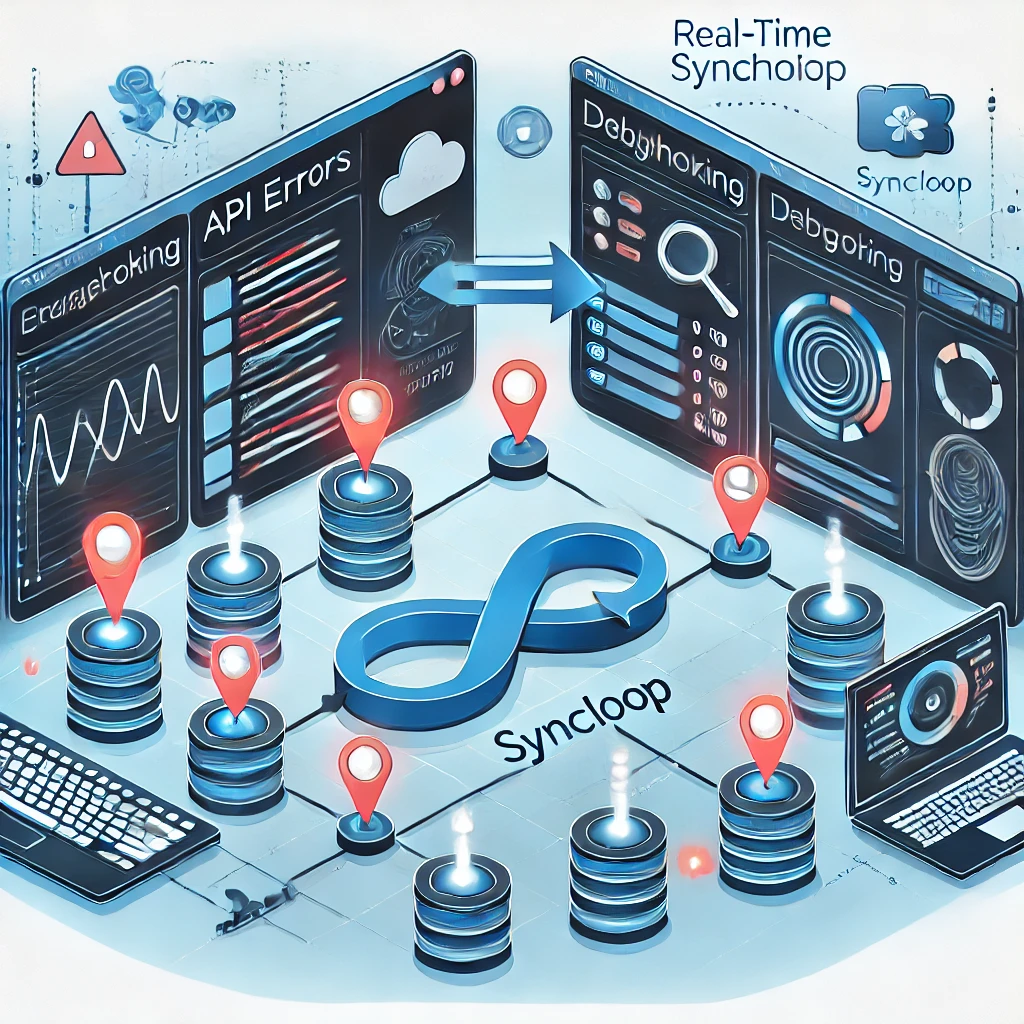Debugging Real-Time API Synchronization Issues with Syncloop

This blog provides insights into common challenges with real-time API synchronization, how Syncloop addresses them, and best practices for debugging these issues.
Understanding Real-Time API Synchronization
Real-time API synchronization refers to the process of continuously updating data across systems or devices without delays. It is widely used in industries like e-commerce, IoT, finance, and logistics.
Challenges often encountered include:
- Latency: Delays in processing or transmitting data can affect synchronization.
- Data Loss: Missing data packets during transmission lead to inconsistencies.
- Concurrency Issues: Conflicts arise when multiple systems update the same data simultaneously.
- Faulty Endpoints: Inaccessible or malfunctioning API endpoints disrupt the synchronization process.
Effective debugging tools and strategies are necessary to mitigate these issues and ensure seamless data flow.
How Syncloop Simplifies Debugging
Syncloop’s API development platform provides comprehensive debugging tools tailored for real-time synchronization. Key features include:
- Real-Time Monitoring: Visualize data flow and identify bottlenecks in real-time.
- Error Logs: Detailed error logs help pinpoint the source of issues.
- Dynamic Data Mapping: Ensure consistent data structures and transformations to avoid synchronization failures.
- Retry Mechanisms: Built-in retry logic automatically handles transient errors.
- Simulation Tools: Simulate API calls under various conditions to identify potential synchronization issues before deployment.
Debugging Real-Time Synchronization Issues with Syncloop
Step 1: Identify the Problem Area
Use Syncloop’s monitoring tools to locate where the synchronization is failing. Common indicators include:
- Incomplete data in target systems.
- Increased latency in API calls.
- Frequent error responses.
Step 2: Analyze Logs
Examine detailed logs provided by Syncloop to identify specific errors. Focus on:
- HTTP status codes (e.g., 404, 500).
- Timeout messages.
- Data transformation errors.
Step 3: Test API Endpoints
Use Syncloop’s testing utilities to validate endpoint functionality. Confirm:
- Endpoint availability.
- Correctness of request and response formats.
- Consistency of data transformations.
Step 4: Check Data Mappings
Ensure that source and target systems share compatible data models. Use Syncloop’s dynamic data mapping features to align field structures and data types.
Step 5: Implement Retry Logic
Enable Syncloop’s retry mechanisms to handle transient failures. Configure the retry interval and maximum attempts to balance responsiveness and system load.
Step 6: Simulate Real-World Scenarios
Leverage Syncloop’s simulation tools to replicate real-world conditions such as high API traffic, concurrency, or network fluctuations. Analyze the results to identify weaknesses.
Step 7: Optimize Performance
Use Syncloop’s analytics dashboard to monitor API performance metrics. Address issues like high latency or limited throughput by optimizing configurations.
Best Practices for Debugging with Syncloop
- Monitor Continuously: Keep a close watch on synchronization metrics using Syncloop’s real-time monitoring tools.
- Establish Error Handling Protocols: Define standard procedures for handling synchronization errors, such as automatic retries or fallback actions.
- Use Version Control for APIs: Maintain version control for APIs to ensure backward compatibility during updates.
- Automate Testing: Regularly test API endpoints using automated tools provided by Syncloop.
- Enable Alerts: Set up alerts for critical errors or anomalies to address issues promptly.
Common Synchronization Issues and Solutions
- Latency in API Calls
- Cause: Network congestion or inefficient processing.
- Solution: Optimize data payloads and enable Syncloop’s caching features.
- Data Mismatches
- Cause: Inconsistent data structures between systems.
- Solution: Use Syncloop’s dynamic data mapping to standardize data formats.
- Endpoint Failures
- Cause: Downtime or misconfiguration of target APIs.
- Solution: Monitor endpoint health using Syncloop’s diagnostic tools and set up fallback mechanisms.
- Concurrency Conflicts
- Cause: Simultaneous updates causing overwrites.
- Solution: Implement locking mechanisms or conflict resolution strategies.
The Benefits of Debugging with Syncloop
- Reduced Downtime: Real-time monitoring and automated retries minimize disruptions.
- Improved Data Accuracy: Syncloop’s mapping and validation tools ensure consistent and accurate data synchronization.
- Enhanced Productivity: User-friendly tools simplify the debugging process, allowing developers to focus on core tasks.
- Scalable Solutions: Syncloop’s platform is designed to handle large-scale deployments, making it suitable for growing businesses.
The Future of Real-Time Synchronization
As businesses continue to rely on real-time data exchange, the demand for efficient and reliable synchronization solutions will grow. Syncloop’s robust platform equips developers with the tools they need to debug and optimize synchronization processes effectively, ensuring seamless operations and superior user experiences.
Image Description
A visualization of real-time API synchronization, showing data flowing between interconnected systems. The image highlights monitoring tools, retry mechanisms, and error resolution workflows enabled by Syncloop.
Back to Blogs